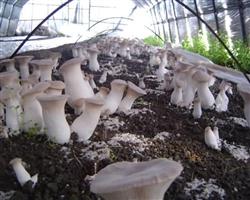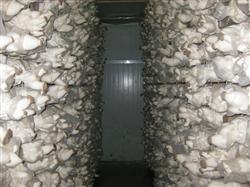Operating rules for cultivation of Pleurotus eryngii

Pleurotus eryngii is a kind of large fleshy umbrella fungus growing in the subtropics, with thick meat, fine and strong stalk tissue, white and thick, and excellent taste. It is a kind of edible fungus that sells well in domestic and foreign markets. The cultivation techniques are introduced as follows: first, culture material formula 1, cottonseed hull 80%, wheat bran 18%, gypsum 2%, lime appropriate amount; 2, cottonseed hull 60%, sawdust 20%, wheat bran 18%, gypsum 2%, lime amount; 3, cottonseed hull 70%, rice straw 10%, wheat bran 18%, gypsum 2%, lime 4. 60% sawdust, 20% corncob, 18% wheat bran, 2% gypsum and appropriate amount of lime. Second, select a formula for making the cultivation bag, mix the material evenly according to the requirements, mix it 1.2 times with water, make the water content of the culture material reach 60%, and adjust the pH at the same time, the pH value is about 7.5. The specification of the cultivation bag is 17x30 cm, each bag contains about 1 kg of wet material, and the plastic rope tightens the mouth of the bag. Third, disinfect and sterilize the stove under atmospheric pressure, keep the water boiled for 8-10 hours, and then be stuffy for 10-12 hours, sterilizing 1000-2000 bags each time. 4. Inoculate, transfer the cooled cultivation bag to the inoculation room, disinfect with chemical and ultraviolet lamp for 30 minutes (or formaldehyde plus potassium permanganate fumigation) and inoculate under aseptic condition, 40-50 bags per bag. Fifth, mycelial growth will be transferred to the cultivation bag (sterilization and disinfection in advance), 80 bags per square meter, or wall stacking, usually 8 floors, keep the indoor temperature 20-26 degrees, check whether there is a contaminated bag after 5-6 days, to remove in time, generally 40-50 days mycelium can be full of bacterial bags. 6. The temperature of mushroom production requires 14-18 ℃, no more than 20 ℃, and the air humidity is 80-90%. Keep the air fresh in the mushroom room. Put the bag flat on the floor of the mushroom room and open the bag after the small buds of the fruiting body are formed in the bag mouth to keep the mushroom moist and do not spray water to the mushroom body. 7. After 5-6 days of fruiting body growth, the single mushroom weighs 50-100 grams, the cap is 3-5 cm, and the stalk is 5-12 cm long.
- Prev

Strain characteristics and cultivation points of snow antler (Pleurotus eryngii) 251
1. After the cultivated species are mentioned in the research institute, the temperature must be paid attention to during packaging and transportation, preferably in the morning or evening, to beware of burning bacteria at high temperature; after the bacteria are brought home, they should be put in a cool, dry and ventilated room for dark light culture. after the bacteria are full of bags, it is better to start inoculating for another 7 days. February, September.
- Next

Industrial cultivation techniques of Pleurotus eryngii
Pleurotus eryngii, also known as Pleurotus ostreatus, is a kind of high-quality large umbrella bacteria in the mountains, grasslands and deserts of southern Europe, northern Africa and Central Asia. The meat is thick, crisp and tender, and has almond flavor, so it is a high-grade edible fungus. The optimum temperature for Pleurotus eryngii was 23-25 ℃, and the temperature for primordium formation was 10-18 ℃.
Related
- Fuxing push coffee new agricultural production and marketing class: lack of small-scale processing plants
- Jujube rice field leisure farm deep ploughing Yilan for five years to create a space for organic food and play
- Nongyu Farm-A trial of organic papaya for brave women with advanced technology
- Four points for attention in the prevention and control of diseases and insect pests of edible fungi
- How to add nutrient solution to Edible Fungi
- Is there any good way to control edible fungus mites?
- Open Inoculation Technology of Edible Fungi
- Is there any clever way to use fertilizer for edible fungus in winter?
- What agents are used to kill the pathogens of edible fungi in the mushroom shed?
- Rapid drying of Edible Fungi

